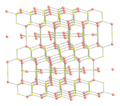Copper monosulfide
Copper monosulfide (CuS) is an inorganic compound with the chemical formula CuS. It is known as a mineral under the name covellite and has a distinctive deep indigo blue color. Copper monosulfide is found in nature as a minor ore of copper and is also produced synthetically for various applications. This compound is of interest not only for its industrial applications but also for its occurrence in natural processes, including those within biological systems.
Properties
Copper monosulfide is a semiconductor and exhibits a range of electrical properties that can be manipulated by doping with other elements. It has a hexagonal crystal structure and is relatively stable under normal conditions. However, it can react with strong acids to produce hydrogen sulfide gas (H2S), a toxic and flammable substance.
Synthesis
Copper monosulfide can be synthesized through several methods. One common approach involves the direct combination of copper and sulfur at high temperatures. Another method is the precipitation of copper(II) ions with sulfide ions in aqueous solution, which results in the formation of CuS along with copper(II) sulfide (CuS2).
Applications
- Industrial Uses
Copper monosulfide is used in the manufacture of solar cells, where it serves as a p-type semiconductor material. It is also utilized in the production of superconductors and as a catalyst in various chemical reactions.
- Biological Significance
In biology, copper monosulfide has been studied for its role in copper homeostasis and metabolism in organisms. It is involved in the formation of copper proteins that are essential for biological functions, including respiration and antioxidant defense.
Health and Safety
Exposure to copper monosulfide should be managed with care, as it can be toxic if ingested or inhaled. The compound can release hydrogen sulfide gas when reacting with acids, posing risks of inhalation hazards. Appropriate safety measures, including the use of personal protective equipment (PPE), are recommended when handling CuS.
Environmental Impact
The mining and processing of copper monosulfide can have environmental impacts, including the release of sulfur compounds into the atmosphere. Proper waste management and pollution control measures are essential to minimize its environmental footprint.
Transform your life with W8MD's budget GLP-1 injections from $125.
W8MD offers a medical weight loss program to lose weight in Philadelphia. Our physician-supervised medical weight loss provides:
- Most insurances accepted or discounted self-pay rates. We will obtain insurance prior authorizations if needed.
- Generic GLP1 weight loss injections from $125 for the starting dose.
- Also offer prescription weight loss medications including Phentermine, Qsymia, Diethylpropion, Contrave etc.
NYC weight loss doctor appointments
Start your NYC weight loss journey today at our NYC medical weight loss and Philadelphia medical weight loss clinics.
- Call 718-946-5500 to lose weight in NYC or for medical weight loss in Philadelphia 215-676-2334.
- Tags:NYC medical weight loss, Philadelphia lose weight Zepbound NYC, Budget GLP1 weight loss injections, Wegovy Philadelphia, Wegovy NYC, Philadelphia medical weight loss, Brookly weight loss and Wegovy NYC
|
WikiMD's Wellness Encyclopedia |
| Let Food Be Thy Medicine Medicine Thy Food - Hippocrates |
Medical Disclaimer: WikiMD is not a substitute for professional medical advice. The information on WikiMD is provided as an information resource only, may be incorrect, outdated or misleading, and is not to be used or relied on for any diagnostic or treatment purposes. Please consult your health care provider before making any healthcare decisions or for guidance about a specific medical condition. WikiMD expressly disclaims responsibility, and shall have no liability, for any damages, loss, injury, or liability whatsoever suffered as a result of your reliance on the information contained in this site. By visiting this site you agree to the foregoing terms and conditions, which may from time to time be changed or supplemented by WikiMD. If you do not agree to the foregoing terms and conditions, you should not enter or use this site. See full disclaimer.
Credits:Most images are courtesy of Wikimedia commons, and templates, categories Wikipedia, licensed under CC BY SA or similar.
Contributors: Prab R. Tumpati, MD





